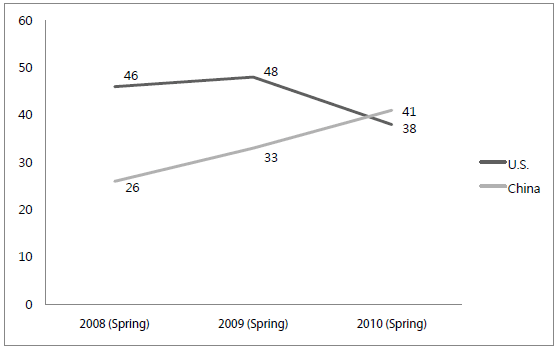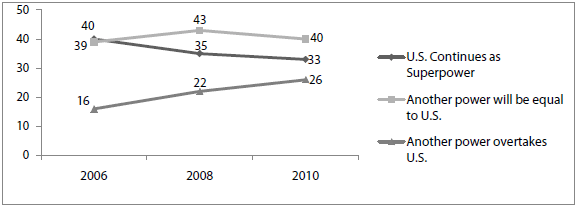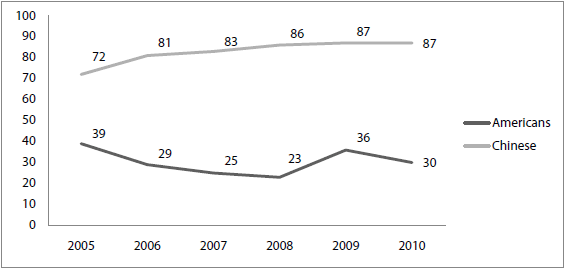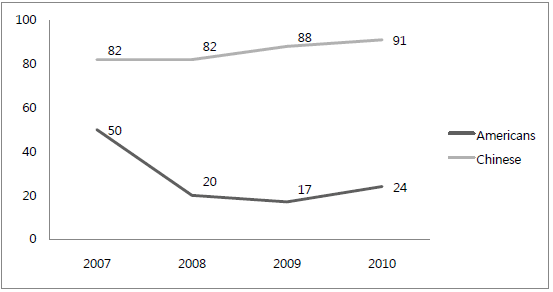![[UCR Watch] Hegemonic Shift? Public Perceptions of U.S.-China Relations](../images/bg_tmp.jpg)
[UCR Watch] Hegemonic Shift? Public Perceptions of U.S.-China Relations
U.S.- China Strategic Competition | Others | 2011-07-05
Stephen Ranger
The Global Financial Crisis that struck in late 2008 provoked further debate on the rise of China and the future of U.S. dominance in the world. Out of this came the talk of a G-2 between China and the United States to cope with the major complex challenges in the world. This seemed to be a significant upgrade from the previous calls for China to become a “responsible stakeholder.” Previously, China had embraced the stakeholder role through various international commitments, for example dispatching naval ships to combat against piracy in the Gulf of Aden but has shown caution toward the idea of a G-2. While it has become more engaged in international issues, Beijing’s behavior adjusted somewhat in 2010 as it has became more assertive on its own national interests.
Beginning with conflicts over arms sales to Taiwan, the visit of the Dalai Lama to the White House, and human rights issues, the disputes between the United States and China reached a height in 2010 over responses to North Korea’s sinking of a South Korean navy vessel. In general, it was observed that China had become more vocal and forceful on the issues that it considers as its “core interests.”
Since the economic crisis, it has been common to perceive of a narrowing power gap between a rising China and a United States in relative decline. Domestic perceptions are at the heart of this and their view of a narrowing power gap has an influence on foreign policy. In China, strong calls for a tougher policy toward the United States from the public have grown since 2008. (Christensen, 2011) Similarly, in the United States there are popular voices for tougher economic policies toward China, in particular on the issue of China’s appreciation of its currency and practices of fair trade. To what extent have domestic perceptions in the United States and China changed toward each other in the Post-Crisis era? Have changing perceptions on the power gap also affected views on bilateral issues?
This U.S.-China Watch attempts to understand Chinese and American domestic opinion on bilateral relations by gathering together data from several public opinion surveys conducted by the Chicago Council on Global Affairs (CCGA), Globescan/Program on International Policy Attitudes (PIPA), and Pew. There are three ways in which domestic views are presented, perceptions of the power gap between the two countries, bilateral perceptions of each other, and global perceptions toward the United States and China. Much of the data in this study covers a timeline from 2005 to 2011 so as to grasp better the changing public opinion before and after the financial crisis.
1. Perceptions of the Power Gap
Pessimistic View of U.S Influence and Power
The view in America toward U.S. influence and power in the world has become more pessimistic reflecting the impact of the financial crisis since 2008. According to the Pew Global Attitudes Project 2010 survey, Americans had tended to view the United States as the leading economic power, but this has ebbed slightly over the years as the recession has taken a hold and the economy struggles to recover (Figure 1). In 2008 46% of Americans viewed the United States as the leading economic power, but by 2010 this had dropped to 38%.
At the same time, there is increasing recognition among Americans of China’s economic ascendency. In 2008 only 26% saw China as the leading economy, yet by 2010 this number had increased to 41%, slightly above the United States (38%). This is in line with much of the common thinking that China will overtake the United States as the leading economy in the next ten to twenty years.
Pessimistic views among Americans are also found when looking toward the future. The Chicago Council on Global Affairs (CCGA) Global Views 2010 survey measured American perceptions on U.S. power in fifty years revealing that they do recognize the power of emerging economies in the world (Figure 2). In 2006, a similar percentage of Americans answered that the United States would continue as the world’s only superpower (40%) or another power would be equal to the United States (39%). However, by 2010 the percentage that sees the United States continuing as a superpower has declined to 33%. Interestingly, the number who sees another power overtaking the United States increased over the same period from 16% to 26%. This reveals that Americans expect the future will be multipolar as Washington will have to contend with rising powers such as China.
Growing Optimism in China
The pessimistic views of U.S. power among Americans are also reflected in current views on the state of the country. When compared with Chinese respondents they are overwhelmingly downbeat. Figure 3 shows the percentage of Americans who are satisfied with the national conditions of their country. The numbers have generally been low, even before the financial crisis began in 2008 and may reflect the general pessimism that characterized the Bush era. The spike in 2009 following Obama’s election may show a new hope for optimism, but the number dips down again in 2010. Chinese respondents, by contrast, express strong satisfaction with the way their country is being run. This certainly reflects strong optimism in China that their country is on the right track.
Figure 4 is more evident of the negative impact that the financial crisis has had on American views of their country. The percentage who believes that the economy is in good shape dips down from 50% in 2007 to 17% in 2009. Chinese respondents have a very strong confidence in their economy, 91% express that China’s economy is in a good shape in 2010.
Figure 1: Percentage of Americans who believe whether the United States or China is the leading economic power today, 2008-2010

Source: Pew Global Attitudes Project 2010, Q25
Figure 2: American Views of U.S Power in Fifty Years, 2006-2010

Source: CCGA Global Views 2010, Q170
Figure 3: Percentage of Respondents Satisfied with the State of their Country, 2005-2010

Source: Pew Global Attitudes Project 2010, Q5
Figure 4: Percentage of Respondents Who Believe National Economy Is In a Good Shape, 2007-2010

Source: Pew Global Attitudes Project 2010, Q12
2. Bilateral Perceptions and U.S.-China Relations
Negative Views
Negative perceptions of the other exist in both China and the United States (Figure 5). Among Americans, only 36% view China’s global influence in a favorable way and for Chinese only 33% view U.S global influence as positive. These low percentages account for the different perceptions that Chinese and Americans hold of each other’s global influence. For Americans, the main negative perceptions of China are related to its growing economic dominance and an increasingly assertive behavior in Asia...(Continued)
Center for China Studies
U.S.- China Strategic Competition
Archives
Others
#38. EAI Internship, What Lies Ahead!
Jiang Chen | 2011-07-05
Others
#37. EAI Internship, What Lies Ahead!
#35. EAI Internship, What Lies Ahead! | 2011-07-05